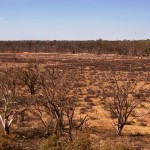
When the Columbia Journalism Review noted Modesto’s dire need for news, most Valley citizens weren’t even aware of the report. Shortly thereafter, the Modesto Bee joined Modesto Irrigation District (MID) General Manager Allen Short and MID Board member Tom Van Groningen in touting a sale of Tuolumne River water to the City of San Francisco.
At the time, the Bee and many of our civic leaders were promoting the notion that the MID had excess water. For people who follow local water issues, the idea was ludicrous.
Virtually everyone with even a remote acquaintance with the drastic shortage of water in California knew that the Federal Energy Regulatory Commission (FERC) and the state of California had little choice but to order increased flows along the Tuolumne, both for the purpose of restoring decimated salmon runs and protecting the San Joaquin Delta ecosystem.
No one knew how much water would be taken, but most experts figured it would be a lot. After all, some eighty percent of the Tuolumne river water had been diverted over the years. No wonder fish populations were down, and no wonder the Delta was endangered.
Bee management seemed surprised when local farmers and their supporters rose as one against the water sale. But Valley farmers have long followed water issues closely. They have to. And they know just how dependent we are on wet years just to maintain reliable water deliveries. They know there is no “excess water.” In fact, in any given year, the state of California is committed to deliver more water than it has; we are over drafted in more ways than one.
Now comes news that the Stanislaus County aquifer is in imminent danger. Suddenly, we’re facing a burgeoning water crisis that no one seems ready to address.
How did it all happen? At least one major factor is widespread ignorance about the precarious state of water supplies in the arid American south west. Enormous amounts of Delta water are shipped south and lifted over the Tehachipis to serve southern California’s insatiable water needs, which have already been a major factor in destruction of the once mighty Colorado River.
More of our precious water is sent to the Westlands Water District, where no one’s been able to solve ongoing problems with salinity for decades. None of these realities were part of Bee management’s presentation of the water sale. Instead, Bee readers were led to believe there is “excess water.”
In fact, until the public becomes far more informed on water issues, we’ll continue sending water south to over built and over populated regions, and we’ll continue delivering water to soils far less suited for agriculture than our own prized Hanford sandy loam. Nothing will change long as the privileged insiders in the Byzantine political process of water allocations are able to exploit public ignorance about the true state of water problems in California.
The real tragedy will be the ongoing loss of local river water to urban uses in overdeveloped regions and to unsustainable agricultural enterprises. The long successful strategy of pitting fish against farmers and farmers against city dwellers will continue for as long as the public remains dependent on media that fail to deliver the whole truth.

Anyone who has been to Los Angeles may be astounded by the water use in the area. Although the Los Angeles basin is a desert, there is little apparent effort to conserve it. Residents are able to use all they want because the Los Angeles Department of Water and Power bought up the rights to water in a large part of the state many years ago. Given the city’s lack of conservation efforts, it is atrocious that valley water is sent south, to our economic detriment.